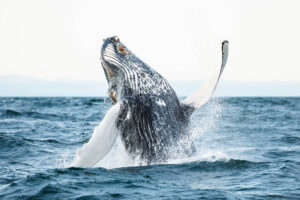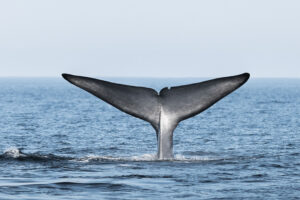Dear reader,
Whalecome, to this introduction to the whales of Skjálfandi bay! There are 5 common species of whales in the bay. Lets start these blogs with the largest of them all, the blue whale!
Scientific name: Balaenoptera
musculus
English name: Blue whale
Icelandic name: Steypireyður
Average life span: 80-90 years
Diet: Krill and small schooling fish
Size: up to 30m
Weight: up to 200 tonnes
The blue whale is the largest animal to have ever lived on our planet. The longest recorded blue whale was a female and measured up to 33,6 meters. Most blue whale reach the length of 29 to 30 meters and males are smaller than the females. This length of the whale can be compared with three buses or 6 elephants. The tongue of the blue whale weights as much as an elephant (6 tons), their heart is the size of a car. The heart beat can be heard from 2 miles (3,2 km) away. Some blood vessels are big enough for a young child to swim through.
The gestation period is 11-12 months and a female can reproduce every three years. When the baby is born its already 8m long and weighs 2700kg. During the first year, the calf will gain 90kg per day by drinking 600L milk. Blue whales, just like other baleen whales migrate to warmer waters to mate and give birth during the winter. During the summer they feed in colder waters like here in Iceland. Blue whales are baleen whales and use the filter feeding technique to catch krill. With filter feeding, baleen whales gulp large amounts of water with the krill and small fishes, then they push the water through the baleens, catching the food in the baleens. An adult can eat up to 36.000kg of krill per day. The average dive during feeding is 10 minutes, it is possible for blue whales to dive upto 20 minutes
Blue whales are graceful swimmers and normally swim at the speed of 8km/h, they can reach the speed of 30km/h if needed. When the blue whale breaches the surface to breath the blow from exhaling can be up to 9m high.
Blue whales use low frequency sounds to communicate, the sounds are so low that we can hardly hear them. Their sounds are one of the loudest on the planet and can be heard from 1600km distance.
The blue whale at the moment has a status of endangered according to the IUCN red list. They are recovering from the whaling in the 1900´s, which nearly drove them to extinction. It is estimated that there are now 10.000 to 25.000 blue whale that swim through all the oceans of the world.
The period with the best chance of seeing blue whales in Skjálfandi bay is from mid-May to mid-July.


